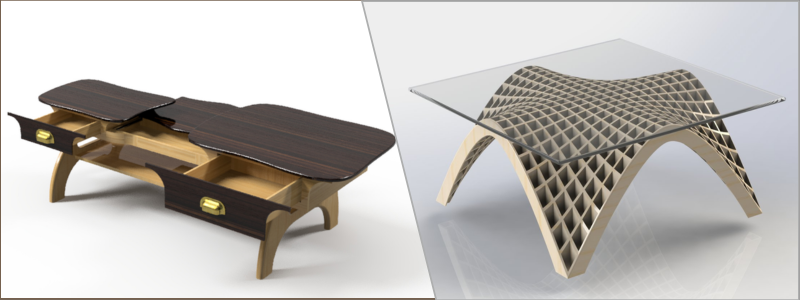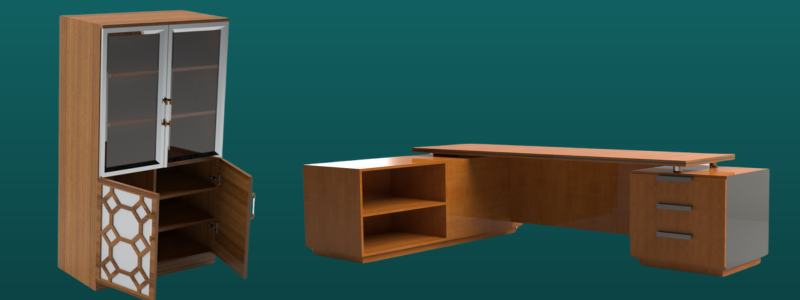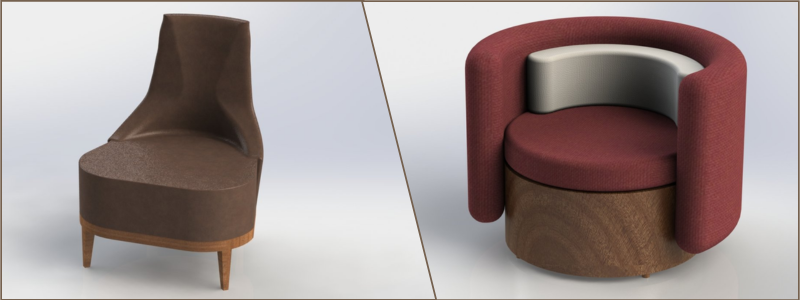As the furniture business becomes increasingly competitive, making products memorable is essential to success. CGI (computer-generated imagery) offers a potent solution that makes it possible for design service organizations to create sophisticated, high-end images of your furniture.
In collaboration with highly advanced 3D rendering services, organizations have the ability to transform product catalogues into 3D realms that highlight insignificant details and become more engaging.
Platforms like CadCrowd offer an array of expert freelance designers waiting to help craft stunning CGI imagery that highlights your products to their full potential, meeting your own personal requirements with precision and subtlety.
With the fast-paced business landscape of furniture design and sales currently in play, it’s more or less equivalent to attempting to scale a peak to stand apart from the pack. From online e-commerce sites to physical retail display rooms, manufacturers and designers continuously seek new methods to capture consumers’ attention and push sales.
Among the strong weapons in attaining this is incorporating computer-generated imagery (CGI) into furniture catalogs. CGI has quickly changed from a specialty marketing tool to an industry standard, revolutionizing product marketing across digital and print channels.
In this section, we are going to elaborate on how CGI can be used to the maximum in revolutionizing furniture catalogs and how interior design service companies can play a major role in it. From increasing visual beauty to extending accessibility, CGI has added new dimensions to presenting furniture products that were out of the imagination in the past.
 Table of contents
Table of contents

What is CGI and how does it work
Before delving into the advantages of CGI for furniture catalogs, let’s learn first what Computer-Generated Imagery (CGI) is and how it works. CGI refers to the application of dedicated computer software to generate images or animations. Whereas conventional photography is the act of recording real objects through a camera lens, CGI builds up digital models of objects from scratch. This is what allows an unprecedented level of accuracy, control, and imagination.
So, what does CGI do? Essentially, CGI involves 3D modeling, texturing, lighting, and rendering. It starts with designing a 3D version of the furniture item using tools such as Blender, 3ds Max, or Cinema 4D. The computer model is the virtual equivalent of the real object, sculpted with exact dimensions and internal structure.
Once the 3D model is ready, the second phase is texturing, where designers apply real-world surface materials such as wood grain, fabric weave, or metallic finish. Through this process, the model imparts depth and realism since it mimics real-world materials.
RELATED: A guide to 3D environment design & concepts with freelance 3D modeling companies
Lighting design services play a significant role in making CGI images look realistic. Just like in a commercial photo studio, virtual lighting setups are adjusted to achieve the best possible appearance of the product. Shadows, highlights, and reflections are finely adjusted to mimic real-world lighting conditions so that the furniture piece looks as realistic as it can be.
Finally, rendering ties it all together. The process of rendering all the computer-created elements turns them into a quality picture or animation. Rendering software, which may be V-Ray or Arnold, calculates the way light behaves when it hits surfaces, bringing forth an image that is seamless from a real-to-life photograph.
The appeal of CGI is in the fact that it provides never-before-possible flexibility. Furniture designers can ask and place their products in ways that are impossible with conventional photography. Need to have a chair in five colors? No problem—CGI allows you to switch color and material at the click of a button. Want to show a sofa in a stylish living room setting? No studio booking is required, and no clunky props are needed to set up. Just create a virtual environment with the perfect ambiance.
This ability to produce product variations without the expense of manufacturing design services or photography makes CGI a useful tool for furniture catalogs. Whether launching a new line or updating an existing one, CGI enables companies to represent their furniture successfully, appealingly, and economically.
The benefits of CGI for furniture catalogs
Quality images
One of the most glaring advantages of CGI is that it can create breathtaking, high-definition visuals that make furniture pieces come alive. Conventional product photography is constrained by the limitations of lighting, camera position, and location. Although these limitations tend to yield less-than-desirable depictions of a product, CGI makes it possible to have full control over all aspects of the scene. Lighting, shadows, and reflections can all be finely tuned to produce the ideal image.
Furniture design service firms that specialize in CGI can produce images that are as realistic as photographs, showing even the minute details of an item. From the grain of a wooden table to the feel of fabric upholstery, CGI makes it possible to show your products accurately and attractively, allowing prospective buyers to see them in their own homes.
Cost efficiency
Producing high-quality photography can be expensive, especially when dealing with a large catalog of products. You’ll need to rent professional studios, hire photographers, pay for props, and potentially bring in models to show the furniture in use. When changes need to be made, such as altering product colors or designs, the costs can add up quickly.
Conversely, CGI is much more economical through 3D modeling design services. Once the 3D models of the furniture are constructed, they can be produced differently without incurring the same ongoing expenses. Furniture catalogs can be updated with new styles, colors, and configurations at a small fraction of the expense of traditional photo shoots. CGI can also be used to create virtual models, keeping the costs of pricey studio space and repeated photography shots to a minimum.
RELATED: How user-centered design improves product design & new prototypes of your company
Flexibility in customization
The largest advantage of CGI is its flexibility. Furniture catalogs have often demanded exposure of a wide range of product choices, from different finishes to multiple sizes, configurations, and accessories. Traditional photography struggles to shoot every variant of a piece of furniture without significant cost and time.
With CGI, design service companies can simply adjust the models to fit any changes or new product lines. If you must show how a specific chair would appear in different materials, fabrics, or colors, CGI can create each version without extra cost. Not only does this allow for the presentation of numerous styles, but it also allows for the creation of interactive catalogs where customers can browse customization options in real time.

Realistic and engaging interactions
Modern furniture catalogs are not solely static images. Customers desire more interactive and richer experiences where they can actually see the furniture in their own houses. With the use of CGI in your catalog, CAD design service companies can create interactive 3D models that customers can rotate, zoom, and view from various angles. This makes the catalog more user-friendly and far more like an imitation shopping experience.
Those interactive features are particularly helpful in online catalogs, where potential buyers can put furniture items into their own homes via AR technology. Buyers can view how a couch, dining table, or chair will look in their living room with CGI-driven AR apps prior to making the purchase.
No geographic restrictions
In furniture design, the geographic reach of your marketing materials can sometimes be a limiting factor. Traditional photography requires visiting locations or studios, which is costly and time-consuming. Moreover, photographing in varying environments (e.g., indoors, outdoors) or simulating the furniture in varying environments can be challenging.
With CGI, design services businesses can create any type of visual without being geographically limited. Whether it’s demonstrating a high-end chair within a sparsely furnished Scandinavian living room or a distressed coffee table in a hip New York loft, CGI provides unlimited options. What’s so wonderful about CGI is that all of these various settings can be created virtually without having to move products or photography gear.
RELATED: 3D product visualization: elevating your online shopping experience and service for modern consumers
Environmental impact and sustainability
Sustainability is becoming a concern in most sectors, including furniture design services and manufacturing. Most conventional product photography entails the movement of furniture pieces to other locations, which can have a considerable carbon footprint. Furthermore, when the furniture catalog needs to be updated or new products need to be included, more physical samples are produced, thus generating waste.
CGI is an environmentally friendly choice. Because no tangible products need to be shipped or replicated, CGI minimizes waste and the environmental impact of catalog printing. A green alternative, it can be sold as a choice to those who are concerned about the environmental sustainability of their purchases.
How design service companies enhance CGI in furniture catalogs
While CGI has numerous benefits, its real potential can be achieved only when the job is carried out with skilled design service companies. These companies are involved in designing photorealistic 3D models and rendering them into shapes that draw out the very essence of the furniture while complementing the imagery of the brand. Let us find out how the role of photorealistic rendering services becomes imperative:
Professional 3D modeling
Creating CGI photos is far more than just running a 3D computer program. Furniture needs to be modeled accurately, and this requires a deep knowledge of design, proportion, material, and texture. Design firms engage their expertise into the battle by having each item of furniture accurately and nicely represented.
Through high-tech 3D scanning techniques, these companies can scan real furniture pieces and create models for them in the virtual world. This is used to model every piece accurately, making the final CGI output replicate the original product.
Personalized lighting and texturing
A significant part of making CGI images look realistic is lighting and texture detail. Design firms can make lighting conditions that simulate natural or artificial light and how the furniture will look in various environments. Ranging from filtered daylight through a window to cozy evening lighting, lighting can impart a mood or atmosphere to a piece of furniture.
Textures are also very significant. Starting from the grain of wood and the texture of fabric, every detail has to be executed so that observers would get a tactile sense of touch of the object. Architectural design service companies know how to add slight details, such as reflections, gloss, and surface imperfections, to allow the furniture to have a tactile sense of existence.
Branding and consistency
When creating a furniture catalog, consistency in all the images is important to portray the brand identity. Branding matters to service design firms, and they can incorporate your company’s style guide into the CGI process. In this manner, each image will harmonize perfectly in your catalog, with the same lighting, color palette, and product placement.
Additionally, design service businesses can curve to your design idea for your brand, whether minimalist, luxury, or eclectic images. Having the flexibility to fit the CGI to a specific brand style is at the core of creating a catalog that resonates with your target market.
Efficient workflow
Furniture manufacturers often need to produce several catalog images within a limited timeframe, sometimes under time pressure. Design service businesses can ease the process by offering existing templates for best-selling furniture models so that they can be manufactured quickly without affecting quality. They can also take care of the entire process flow, from architectural model-making services to rendering, so that the catalog creation process is seamless and streamlined.
By taking the technical responsibility of CGI production off your hands, design service companies free up your personnel to focus on other aspects of your business, such as sales and marketing.
RELATED: Furniture business sales: roles of 3D product rendering from CAD design services provider

Conclusion: revolutionizing furniture catalogs with CGI
In a world where images are worth more than ever before, the addition of CGI in furniture catalogs is a godsend that regular photography cannot match. From taking high-quality images to offering customization features and promoting sustainability, CGI allows you to present your furniture products in the most favorable light for your consumer product company.
It is through collaboration with competent design service companies that you get to enjoy the maximum advantage of CGI and have your furniture catalog not only be visually appealing but also convey your brand message and goals clearly. With the use of CGI, furniture makers and designers can enhance their advertising campaigns in ways that make the user have fun and engage in an interactive experience, which increases sales and enhances brand loyalty.
Cad Crowd is here to help
Expanding your furniture catalogs with CGI is a powerful way of displaying your products visually attractive and in painstaking detail. Using state-of-the-art 3D rendering technology, design service companies can create beautiful, realistic images that highlight the elegance and characteristics of your furniture much more effectively than traditional photography.
By choosing to collaborate with talented freelancers from Cad Crowd, you will be able to tap into an international talent pool of experienced CAD designers who will be in a position to bring your vision to life with precision and imagination.
Whether it’s taking your catalogue pictures to a whole new level or including product specifications with dynamic 3D models, the work of the right professionals can benefit your business as a key differentiator in the global economy. Hire a freelance designer now and take your furniture catalogue to a whole new level with CGI. Request a free quote today.
The post Improve Furniture Catalogs with CGI to Market Your Products with Design Service Companies first appeared on Cad Crowd.